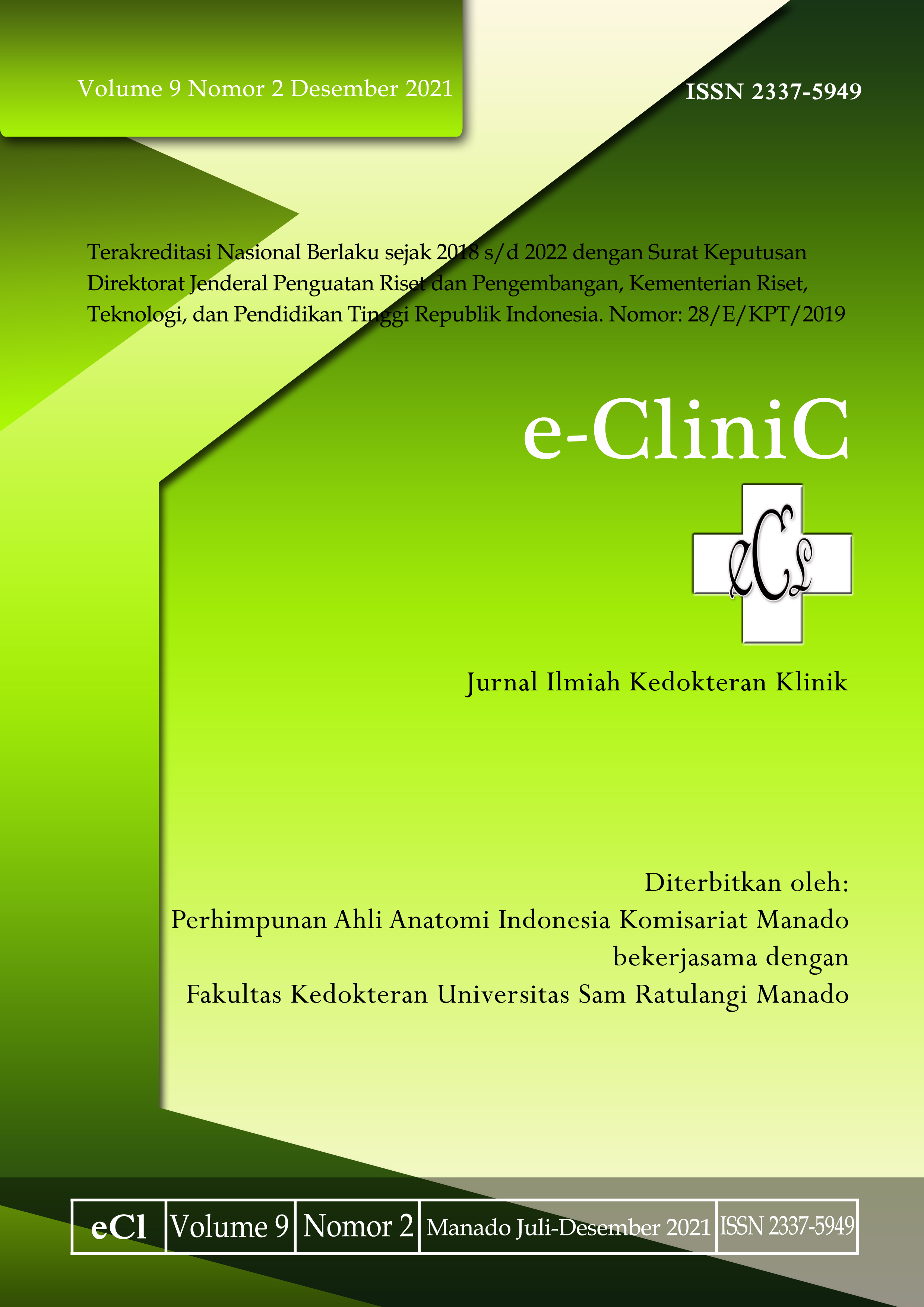Efek Terapi Adjuvan Extracorporal Shockwave terhadap Penyembuhan Ulkus Kaki Diabetik Penyandang Diabetes Melitus Tipe 2 dengan Penanda Vascular Endothelial Growth Factor
DOI:
https://doi.org/10.35790/ecl.v9i2.36158Abstract
Abstract: Diabetic foot ulcer (DFU) prevalence tends to increase every year. Within 30 seconds it is predicted that one leg will be amputated due to DFU. New blood formation triggered by adjuvant extracorporeal shock wave therapy (ESWT) on increasing VEGF level is expected to promote DFU healing. This study was aimed to prove whether ESWT as an adjuvant therapy could stimulate DFU healing by increasing VEGF serum level. This was a quasi-experimental study using two groups, the ESWT and the control groups. Two repeated measurements of VEGF levels and PEDIS scores were performed. The ESWT group (17 patients) received the adjuvant ESWT and the control group (7 patients) received conventional wound care therapy. Both groups received 8-time treatment for 4 weeks. Measurements of VEGF levels and PEDIS scores were performed at baseline and after 4 weeks. The results showed that the PEDIS score of the ESWT group decreased, albeit, not in the control group. The VEGF level of the ESWT group significantly increased (mean rank=13.24) compared to the control group (mean rank=7.33). The Wilcoxon signed-ranks test indicated that the PEDIS score in ESWT group had a significant decrease compared to the control group (mean rank=7.50), Z=-3.372, p=<.001. The Pearson correlation test showed a significant relationship between VEGF value and the PEDIS score reduction (81.4%). In conclusion, the adjuvant ESWT therapy could promote DFU healing (reduced PEDIS score) and increase VEGF levels in DFU patients.
Keywords: ESWT; VEGF; diabetic foot ulcer (DFU)
Â
Abstrak: Prevalensi ulkus kaki dibetik (UKD) terus meningkat setiap tahunnya dan dalam 30 detik diprediksi terdapat satu kaki yang diamputasi karena UKD. Pembentukan pembuluh darah baru yang dipicu oleh penggunaan adjuvan ESWT terhadap peningkatan kadar VEGF diharapkan dapat memper-cepat penyembuhan UKD. Penelitian ini bertujuan untuk membuktikan terapi adjuvan ESWT dapat meningkatkan kadar VEGF dalam penyembuhan UKD. Jenis penelitan ialah kuasi-eksperimental yang membandingkan dua kelompok perlakuan (ESWT vs kontrol) melalui dua pengukuran berulang terhadap kadar VEGF dan skor pedis. Kelompok ESWT (17 pasien) mendapatkan terapi adjuvan ESWT dan kelompok kontrol (7 pasien) mendapatkan terapi konvensional perawatan luka. Kedua kelompok mendapatkan perlakuan 2 kali per minggu selama 4 minggu. Pengukuran kadar VEGF dan skor pedis pada baseline dan setelah selesai 4 minggu perlakuan. Hasil penelitian mendapatkan penurunan skor PEDIS hanya pada kelompok ESWT (14 pasien), Kadar VEGF kelompok perlakuan didapatkan meningkat bermakna (mean rank=13,24) dibandingkan kelompok kontrol (mean rank=7,33) (p<0,001). Wilcoxon Signed-Ranks Test mengindikasikan bahwa nilai skor PEDIS kelompok ESWT mengalami penurunan bermakna dibandingkan kelompok kontrol (mean rank=7,0), Z=-3,372, p=<0,001. Uji korelasi Pearson menunjukkan hubungan bermakna antara perubahan nilai VEGF dengan skor pedis (81,4%). Simpulan penelitian ini ialah terapi adjuvan ESWT dapat memicu penyembuhan UKD (menurunkan skor PEDIS) dan meningkatkan kadar VEGF pada pasien UKD
Kata kunci: ESWT; VEGF; ulkus kaki diabetik (UKD)
Downloads
Published
How to Cite
Issue
Section
License
COPYRIGHT
Authors who publish with this journal agree to the following terms:
Authors hold their copyright and grant this journal the privilege of first publication, with the work simultaneously licensed under a Creative Commons Attribution License that permits others to impart the work with an acknowledgment of the work's origin and initial publication by this journal.
Authors can enter into separate or additional contractual arrangements for the non-exclusive distribution of the journal's published version of the work (for example, post it to an institutional repository or publish it in a book), with an acknowledgment of its underlying publication in this journal.
Authors are permitted and encouraged to post their work online (for example, in institutional repositories or on their website) as it can lead to productive exchanges, as well as earlier and greater citation of the published work (See The Effect of Open Access).







